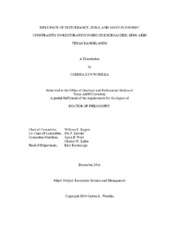| dc.description.abstract | Reducing brush has been a major goal of rangeland restoration because of increases in densities of native woody plants in recent decades. However, land managers attempting restoration are faced with diverse socio-economic and biophysical variables that interact to drive community shifts following interventions in encroached rangelands. I implemented a complementary set of studies to explore the drivers of vegetation response to disturbance. I designed an experiment to determine the relative resilience, or capacity to absorb disturbance without switching to an alternate state, of the woody dominated state in a brush encroached rangeland across soils with different textures: fine clays to coarse sands. I exposed plots on each soil type to one of three brush removal treatments: untreated control, hand-cutting with herbicide application, and roller-chopping. In addition, I mapped grass basal areas to determine differences in mortality, recruitment, and species turnover resulting from brush removal treatments.
Despite widespread application in the study region, the two brush reduction methods assessed in this study were not ubiquitously effective at overcoming the resilience of the woody plant dominated state. On sandy soils woody plants quickly regained pretreatment levels of dominance. However, on clay soils, grass remained dominant for the duration of the study, suggesting that, both cut-herbicide and mechanical treatments overcame shrubland resilience. This finding provides a baseline for prioritizing restoration strategies, allowing managers to target underlying conditions that are more conducive to restoration with lower levels of intervention. In addition, I found perennial grass mortality to be higher in mechanically treated plots on all soil types than in chemically treated plots, suggesting cut-herbicide might be favorable to mechanical brush control for avoiding undesirable herbaceous community compositional shifts. Finally, recognizing the potential for social barriers to prevent adoption of ecologically effective interventions, I analyzed the effect of prescribed burning regulations and liability standards on prescribed fire use on private lands. Limited liability standards coupled with strict regulatory requirements increased the use of prescribed fire. This information can be used to formulate prescribed burning legislation that will promote the safe and effective use of prescribed fire for restoration and conservation of fire-dependent ecosystems. | en |


